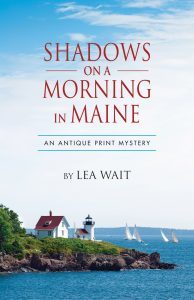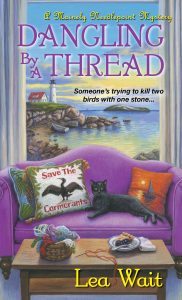Making the Pieces Fit: Building a Mystery
Lea Wait, here, taking a deep breath between publication of my SHADOWS ON A MORNING IN MAINE a little less than two weeks ago … and publication of DANGLING BY A THREAD, October 24.
Of course, I’m sitting around or being bored. My next manuscript is due to my editor December 1. So, while I’ve been talking about this fall’s publications, I’ve been thinking a lot about plots, characters, clues, pacing … all the elements that, put together in the “right” order … become a mystery. Most specifically, I’m thinking about the book I’m writing.
My grandmother used to spread the pieces of a large jigsaw puzzle on the corner of our dining room table. (Except at holidays, when the table was actually used for dining. But that’s another story.) When I passed the table I was always tempted (as were other members of the family) to add one or more pieces. Matching colors were sorted. Edges were put together first. Corners were the easy parts. But seeing a picture in terms of shapes didn’t come easily to me. I enjoyed the puzzles, but I was not a master at jigsaw puzzle solving.
And now I write mysteries. Some authors are “seat of the pants writers” (“pantsers,” for short.) They sit at their computer keyboards and words flow, turning magically into characters and plots and solutions.
That’s not me. (I wrote one book that way, and it’s the only mystery I’ve written that has not sold. And it took three times as long to write as I normally allotted.)
I’m an “outliner.” Not the sort my fifth grade history teacher insisted on, with large As and small, Roman numerals and Arabic. But an outline of the plot and characters, nevertheless.
True, I leave some plot details to imagination (or serendipity,) to be developed while I write. But before I put my hands on that keyboard I know where I’m going to start, where I’m going to end, and have a fairly detailed idea of what will happen between those points.
When I speak at schools I often explain that writing is like putting together a giant jigsaw puzzle … a puzzle that begins with all white pieces, and no edges. The pieces are parts of the book: characters. Scenes. Weather. Time frames. Clues. A murder weapon (or two.) Suspects. Motivations.
Is it winter, or spring? Is my protagonist angry or contented, haunted by his or her past, or afraid of the future? Why does he or she get involved with solving the crime? Who will die? Why? How? Do they deserve it? What secrets do each of the main characters have? Do those secrets overlap? How do they complicate the plot?
Some puzzle pieces are the characters’ backstories. Their relationships with each other, then and now. Is there a romance? Is it in trouble? Is there a business that must be run while the crime is being solved? Are there children or elderly relatives who must be cared for? Friends with difficulties? Do any of the characters have flaws that complicate resolving the crime?
What about the unpredictable. Will there be a storm? A flood? An automobile accident? An unrelated crime that confuses both the police (yes, they’re in there, too) and the protagonist?
Could there be a second murder? Or even a third?
The answers to all of those questions become jigsaw puzzle pieces that, when best put together, tell a story.
Sometimes sub-plots or minor characters take over, and demand more than their share of the puzzle. Theses must be ruthlessly disconnected from the rest of the plot and tossed on the floor, perhaps for a dog to nibble or a cat to hide. They have no place in the completed puzzle.
So now, as (I hope!) readers are sitting back and reading SHADOWS ON A MORNING IN MAINE, or anticipating and pre-ordering DANGLING BY A THREAD, I’m organizing the pieces of a Christmas mystery set in Haven Harbor, Maine which will be published in November of 2017. I know who dies. I’m pretty sure who the murderer is. I want to set my characters and plot in a realistic (but slightly glamorized) Maine holiday setting.
And, of course, there will be red herrings and Christmas ornaments and eggnog and cats and lots of motivations and secrets.
When the puzzle is complete, I hope the picture I’ve put together is a true one, and a Christmas my readers won’t forget — at least for about three hundred pages.
For right now … I’m putting together the pieces.
Lea Wait's Blog
- Lea Wait's profile
- 506 followers



